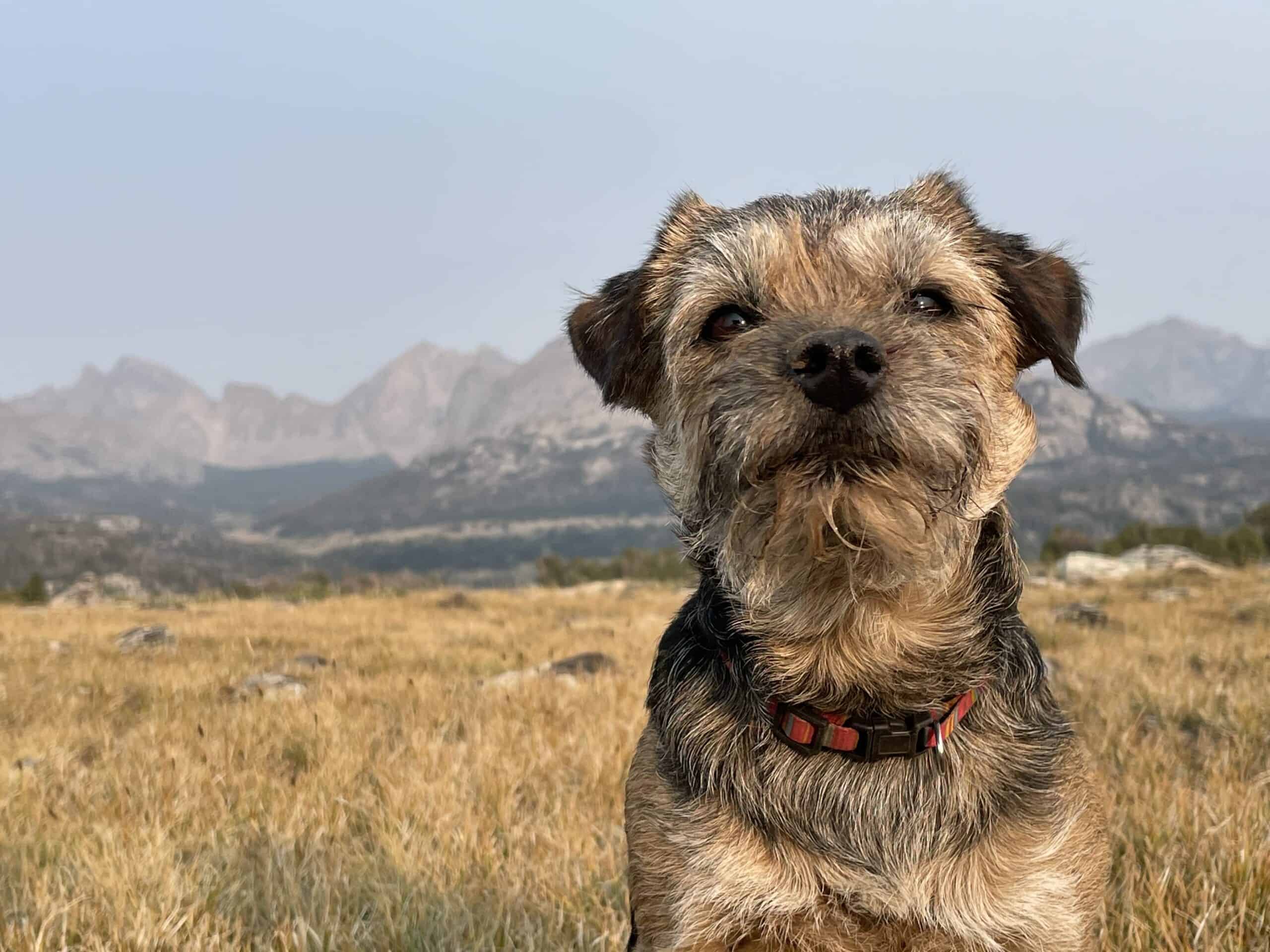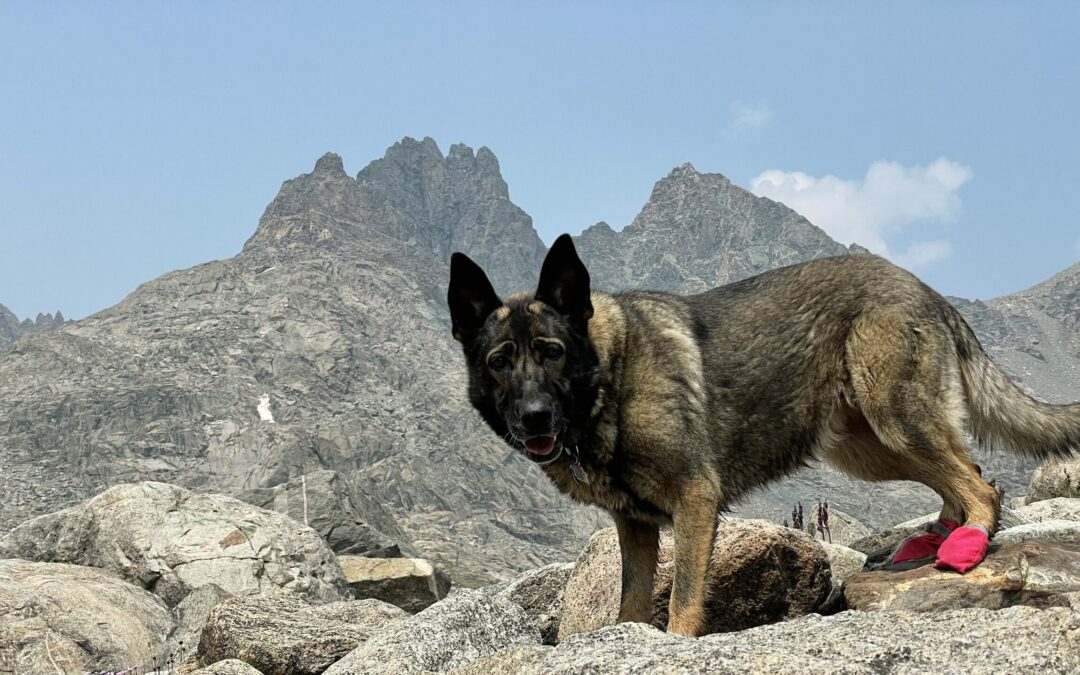By Bailey Bremner, aka PseudoSloth
After a rainy morning, the summertime sun shone down on Prima, Skittles, and me as we approached the silver pillar. On one side the words “United States” stood out, on the other “Canada”. After taking a few pictures and absorbing the moment, we set off down the road heading south feeling giddy and excited for the adventure to come. Little did I know the highs and lows we would face on our adventure together, especially considering that both Prima and Skittles are not the trail names of my friends, but those of my two trusty canine companions.
While the Continental Divide Trail [CDT] was not my first thru-hike with a dog, it was the longest we had hiked together to date. Thru-hiking with a dog presents many unique challenges, many of which we faced throughout our trek. Here I will be sharing the story of our hike, highlighting many of the common questions potential hikers ask as well as how my dogs and I tackled them.
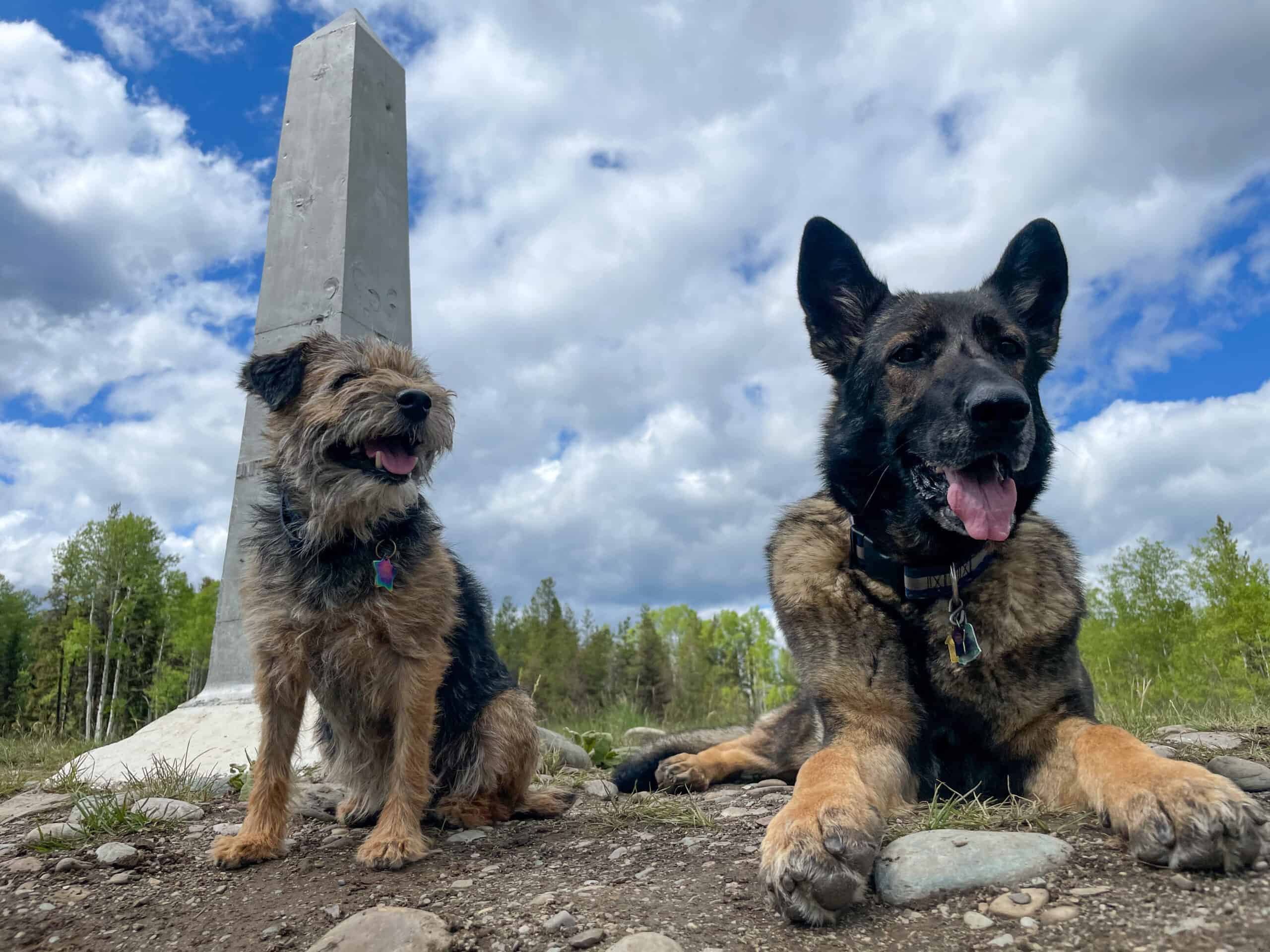
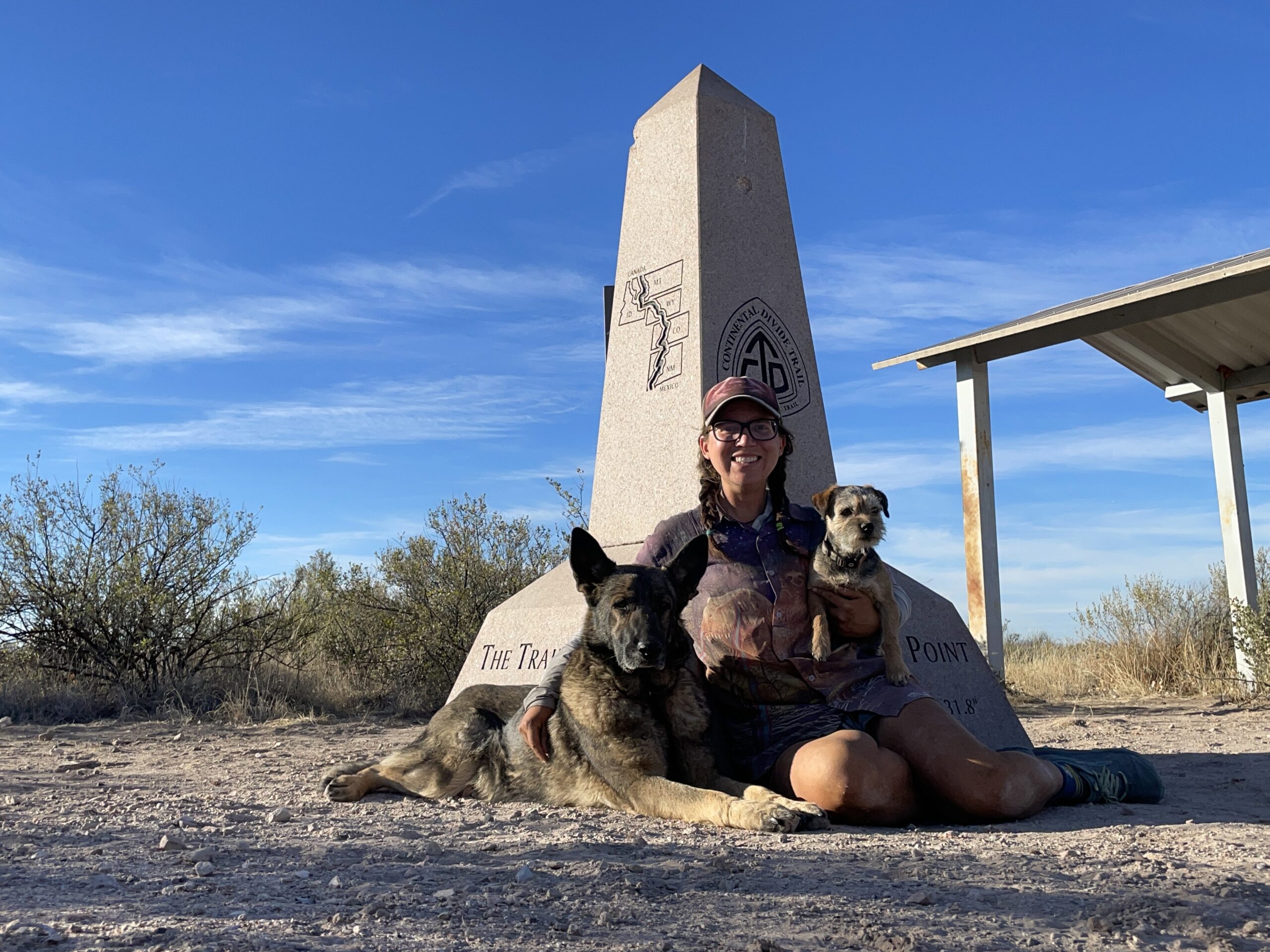
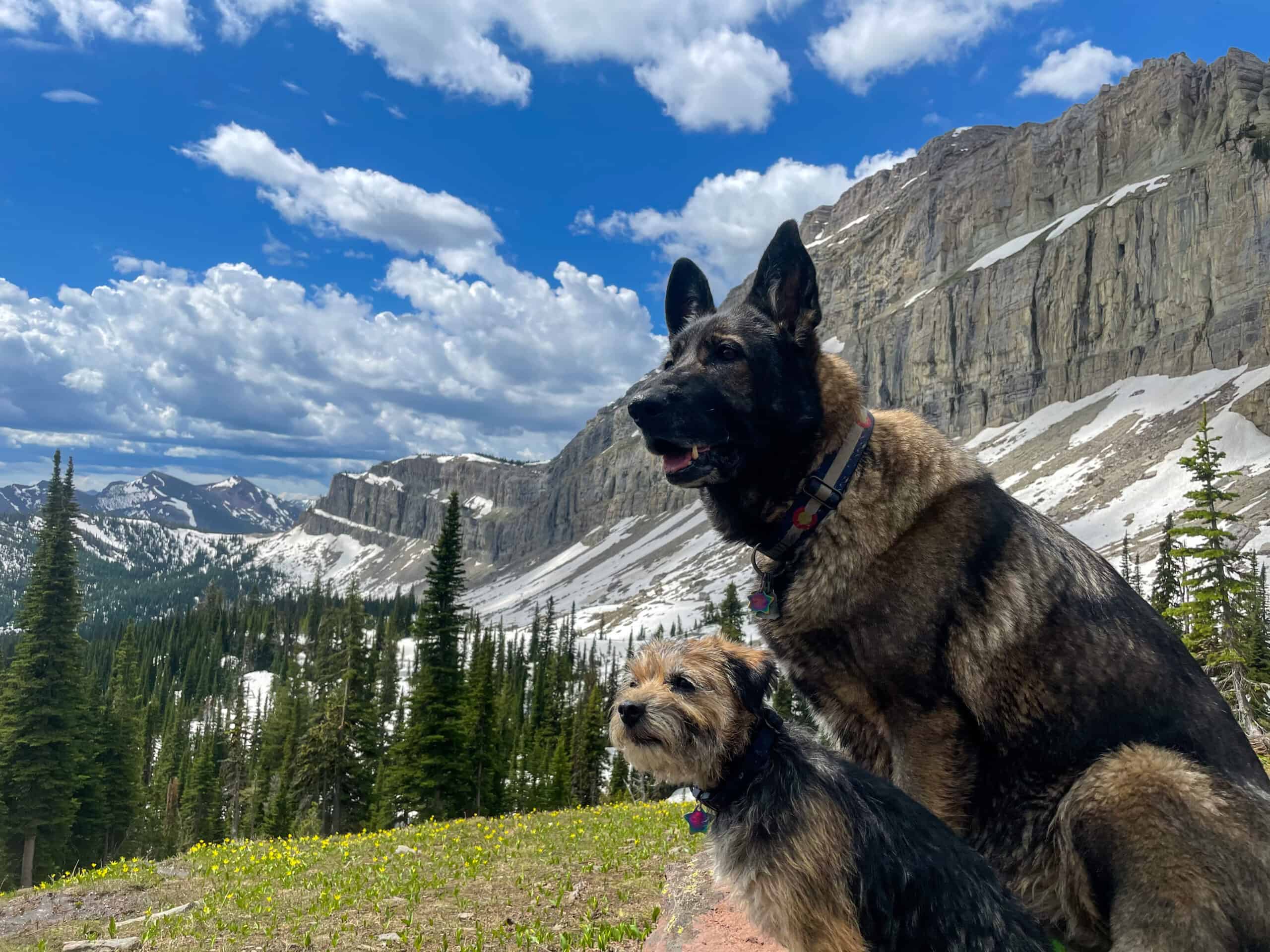
MONTANA
Four words come to mind when I think back to our time in Nevada: hot, dry, and sad feet! After hitching in the rain that first morning, we saw little in the way of moisture while hiking through the forests of Montana. We headed south along the shores of Hungry Horse Reservoir to avoid breaking any rules in Glacier National Park, then entered the enigmatic Bob Marshall Wilderness where we got to play in some snow along the Chinese Wall. Both Prima and Skittles were happy and I began to increase our daily mileage since they seemed to be doing well. That didn’t last for long.
As we approached the town of Lincoln, Skittles began to limp. I didn’t know at the time, but the arid conditions were putting a toll on her feet. We slowed down, took days off, and even saw a vet in Helena to make sure something more serious wasn’t the culprit. Her feet eventually recovered by the time we left Butte, but then Prima began to have problems. It was a stressful time for me as I wanted to ensure that my hiking buddies were having as much fun as I was. It made it difficult at times to enjoy the beautiful sunsets, forested ridges, and rock walls that we passed throughout the state.
When it comes to thru-hiking with dogs, foot care is one of the biggest considerations. All dogs are different, so it may take some trial and error to figure things out. For example, my small dog, Skittles, rarely has foot problems anymore. It has to be very dry and rocky for her feet to become sore. Prima on the other hand has “princess feet”. No matter what foot products I apply or how careful I am, she tends to get sore after 5 or so days of hiking in dry climates. Boots have helped, but can also be detrimental for those pups who have dew claws.
Thruhiking with Dogs TIP #1-
Make sure to take care of your dog’s feet! Here are some strategies that I have used:
- Try to condition your dog’s feet before starting your hike and start your hike with lower mileage to allow their feet to toughen up.
- Bring a dog-specific foot balm to apply to their feet each night. Be careful not to use too much or something that will soften the pads (such as bag balm) as that can lead to further injuries.
- Bring boots even if your dog has never experienced foot problems. Worst case, they can be used to help protect an injured foot and don’t weigh much depending on the brand. Try different styles and models out to find what works best for your dog and where you are hiking.
- Be cognizant of the terrain where you are hiking. Granite, lava rocks, road walking, off-trail rocky terrain, and arid climates tend to be harder on dog feet than substrates such as dirt, grass, or leaf litter.
- Be prepared to take more zeros than the average hiker. Some dogs have sensitive feet no matter what you do, giving them time to recover every week will go a long way.
WYOMING
As we completed our first state and started to get most of the foot problems under control, the great beauty of northern Wyoming engulfed us. Our route took us around the outside of Yellowstone National Park along the John D Rockefeller Parkway. One of the biggest highlights of any hike we have completed was seeing a family of river otters playing in the Snake River before hiking up into the Teton Wilderness to reconnect with the official CDT.
Heading into and throughout the Wind River Range we consistently pulled 20-mile days, trekking over passes surrounded by granite spires and past a multitude of lakes. The scenery was spectacular and it felt like our bond was only growing stronger by the day. This was especially true hiking over the beautiful, but challenging Knapsack Col.
One problem the dogs never struggled with on the CDT, even with back-to-back high mileage days, was losing weight. I decided before the hike to keep feeding them high-calorie sport dog kibble for several reasons. Different hikers choose to use different foods for their dogs, but regardless of what you choose the following are practical considerations to keep in mind.
Thruhiking with Dogs TIP #2-
Choose a high-quality food that will provide your dog with the energy to perform for months at a time.
- Consider a brand that is readily available at farm supply stores such as Tractor Supply or Murdochs. Most mid-sized towns such as Butte, MT and Salida, CO have farm stores, but chain pet stores such as PetSmart are less common.
- Calories aren’t everything. While feeding food with higher calories is helpful, fat and protein content should also be taken into consideration to support endurance activities. Consult a veterinary nutritionist if you need help!
- Even if you plan to resupply as you go, consider leaving a few emergency resupply boxes with family or friends. Most dog food ordered online is mailed by either FedEx or UPS, so the post office will not reliably accept these as general delivery shipments if you are in a last-minute bind.
- Feed more food than you think your dog needs to start, then scale back if they gain weight.
As we descended out of the Winds and into the Great Divide Basin, the landscape began to change. Pine trees morphed into sagebrush and the views opened up on every side. I knew going into it that this section was going to be one of the most difficult to hike with the dogs. The open landscape meant little in the way of shade and water would be scarce. We were fortunate to start the walk across the basin during a cold front which made daytime temperatures more manageable, but the exposure to the sun and wind was still tiring. As we made our way closer and closer to Rawlins the days heated up more and more. I began to push us harder to camp close to water sources and try to complete this stretch before the heat set back in. The dogs were tired but kept up like champs. It can’t be all rainbows all the time, and this section was a reality check after the highs of the mountains before.
Fortunately, both Prima and Skittles were in great condition by this point in the hike. I knew them well enough to know when I could push them safely, but it was a fine balance. Pre-hike conditioning, breed history, physical structure, and personality all contribute to a dog’s ability to stand up to the rigors of thru-hiking. Luckily Prima and Skittles have the right combination of traits to thrive on a thru hike and after a few days off in Rawlins we made our way to Colorado.
Thruhiking with Dogs TIP #3-
Know your dog and adequately prepare them for the trail.
- Dog breeds that were bred for work, especially endurance activities, tend to have the most success thru-hiking. Herding breeds, hunting breeds, and terriers are just a few examples of the dogs that typically excel on the trail, though it isn’t a hard and fast rule. If you have a mixed breed, consider what breeds most likely make up the mix.
- Physical structure will impact a dog’s short and long-term ability to hike. Genetic conditions such as hip or elbow dysplasia and luxating patellas cause excessive wear and tear on the joints with repetitive movements leading to arthritis at a younger age. Even if a young dog seems able and happy to hike in the present, the repeated impact from the mileage required to hike the CDT will most likely cause them to slow down at a younger age than their counterparts.
- Work on conditioning before the hike and start the trail at a slower pace. Give your dog time to work up to higher mileage days.
- Some dogs just don’t like thru-hiking and that’s okay. Even if they enjoy day hikes, they may not have the personality for thru-hiking. Others will thrive more than ever on the trail.
COLORADO
As our home state, I was looking forward to making it to the Centennial State. I had a goal of making it to the state line by September 1st and on that day we began a long stretch of beautiful ridges, golden aspen leaves, and running from winter. After visiting several friends near Steamboat, we tackled a string of peaks and passes including Park View, James, and Grays Peaks. The reward of working together to scramble down the ridges of the Skyline Traverse made me feel so much closer to both dogs. We were invincible! It was also a dream come true to hike down trails I had hiked in the past, such as Herman Gulch, with the golden tundra and brilliant blue sky all around us. Prima loved the cool weather and Skittles was excited to see her friends, the marmots, once again.
As we progressed further south it became apparent that we were losing the race with winter. A dusting of snow on Grays Peak, then four out of five days in the Collegiates sent a strong message that we needed to keep pushing south. Of course, Prima just LOVED romping in the snow, scooping it up like an excavator as she trotted along. However, sleeping with a wet dog in sub-freezing temps is no fun, so we took the Great Divide Bike Route Alternate to bypass the San Juans. This proved to be a wise choice as even so, we spent the night out in the snow near the Summitville mine. Prima may not have minded, but putting on frozen shoes the next morning was not my favorite.
This section, and the whole hike, would not have been possible without some careful gear selection choices. Extra water capacity for Montana and New Mexico, dog sleeping pads for the cold nights in Colorado, and raincoats for the snow all helped to keep the dogs more comfortable on the trail.
Thruhiking with Dogs TIP #4-
Be creative with your gear choices.
- Consider what challenges you will be facing such as long water carries, hiking in grizzly bear habitat, and dealing with snow. What gear will your dogs need to stay safe and comfortable in those conditions?
- Keep it simple. There are so many fun and exciting dog accessories on the market, but most of them are not necessary for the majority of dogs. Others may not offer enough of a leg up for the weight penalty.
- Some suggestions for gear all dogs will need- leash, collar, bowl, water container(s), boots, poop bags, rabies and vaccine information, first aid supplies
- Optional gear depending on the dog and section- blanket, sleeping pad, umbrella, rain jacket, warm jacket, nail clippers, harness, toy, treats, bear bell
- Your dog may not need (or want) to carry a pack. Some dogs do just fine wearing a pack, but in many cases, they cause more problems than they are worth. Some common problems include needing to be adjusted frequently, causing the pads to become sore more quickly, chafe from rubbing, increased calorie usage, and extra wear and tear on the joints. Most dogs that start with a pack won’t finish with one.
- Don’t be afraid to adjust on the trail. Most items can be ordered online or bought in town if you think of something you need on the trail.
NEW MEXICO
Out of all the states we hiked, New Mexico was the biggest surprise. Snow in the north, lava fields, rocky pinnacles, oceans of yellow grass, so many cows, and hardly anyone in sight. I had heard so many poor remarks about New Mexico, that I was surprised at how lovely it was. The variety throughout the state was incredible and autumn temps were perfect for hiking with the dogs. While the state overall was dry, I didn’t find any of the water carries to be any worse than some of those found in central Montana or the basin.
As our last state and the threat of winter now mostly past, we slowed down and took our time. This gave the dogs plenty of time to sniff around while hiking and rest up on zero days. While my choice to hike SOBO was primarily a product of my work schedule, it turned out for the best. Trail choice and planning can make such a big impact on the overall experience of the hike, especially for a dog!
Thruhiking with Dogs TIP #5-
Choose your trail and direction carefully:
- If you are looking to tackle your first thru-hike with your dog, trail choice can impact success! Choosing a trail that is close to family and friends means you will have a support network should something go wrong. A trail that is near where you live also means you will be more familiar with the terrain and conditions.
- Consider how dog-friendly the trail is and whether you are open to alternates. The CDT is very dog friendly overall and there are feasible alternates to bypass the three national parks that prohibit dogs.
- SOBO or NOBO? On some trails this may not make as big of a difference, but on others, the direction you choose to hike can impact how difficult the hike is in the first few days or weeks, the weather window, and how long the hiking season is.
As we hiked through the bootheel and approached the southern terminus, I did a lot of reflecting. There were certainly many challenges hiking the CDT with Prima and Skittles, I wasn’t perfect and our hike wasn’t a fairy tale all the time. However, in the last days and beyond I came to appreciate how much all three of us grew and how much stronger our bond became. Like anything, thru-hiking with a dog can take some trial and error, so long as their well-being and safety are made a top priority. On December 7th we reached Crazy Cook, concluding an amazing adventure and opening the door for many more.
Follow Bailey’s adventures @the_most_important_step!
